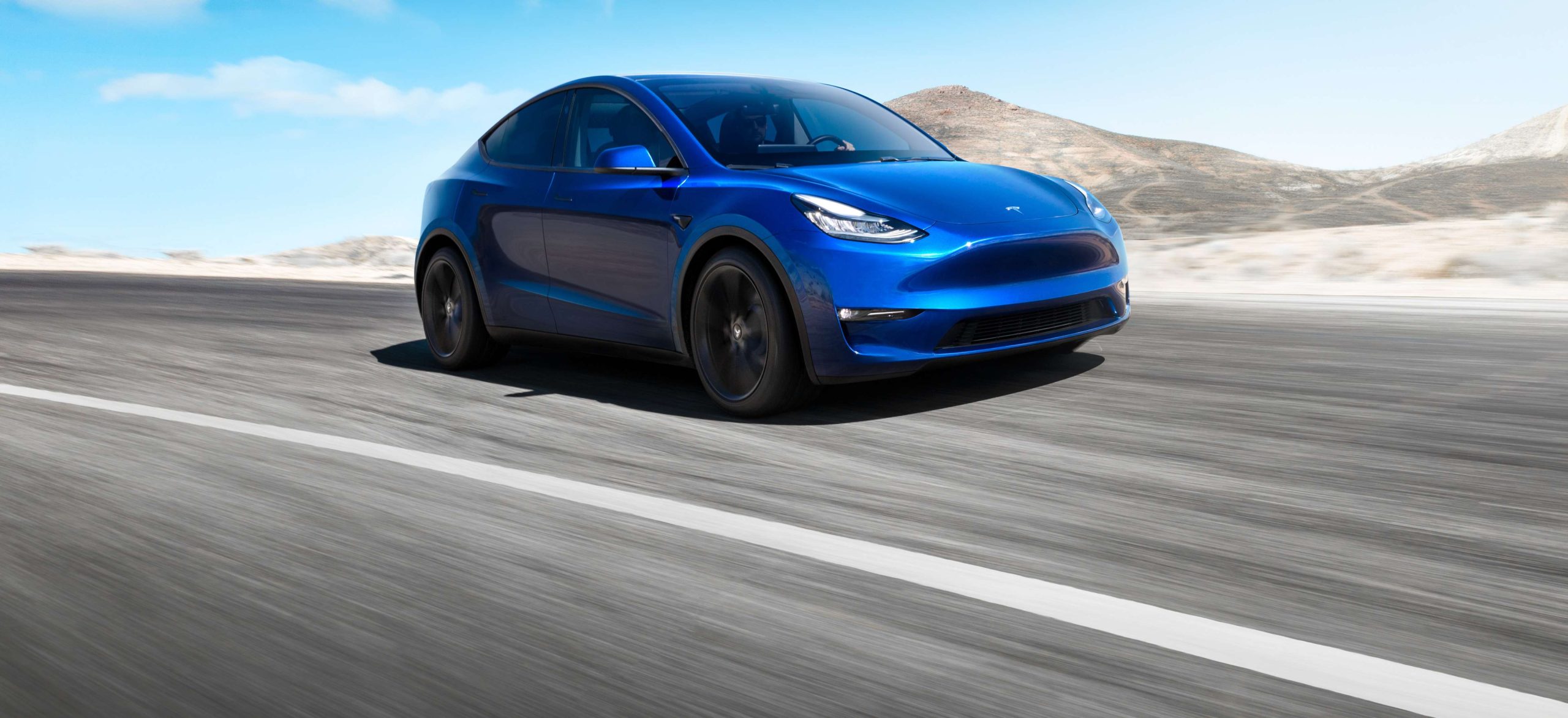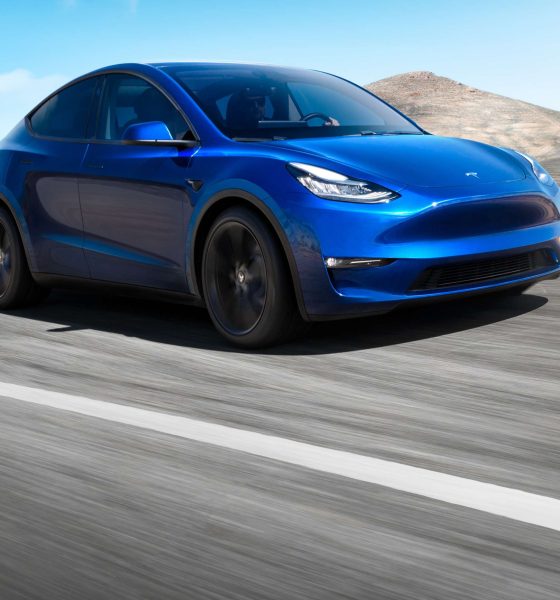The Tesla Model Y has been unveiled, and it will likely prove to be one of the electric car maker’s best-selling vehicles. Equipped with a robust set of features and offered at a reasonable price, the Model Y has the potential to disrupt the highly lucrative crossover SUV market the same way that its sibling, the Model 3, disrupted the passenger sedan segment in the US last year.
As the market prepares for the arrival of the Model Y, it becomes pertinent to compare it to other all-electric SUVs in the market. So far, there are two that are pretty close to the Model Y in size: the Audi e-tron and the Jaguar I-PACE. Faced with this competition, how does the Model Y stack up?
Tesla Model Y

The Model Y could be described as a larger, bulkier version of the Model 3. Similar to the electric sedan, the Tesla Model Y is offered in either RWD or AWD options. The vehicle starts at a $39,000 for the Standard Range version and goes all the way to $60,000 for the Performance variant. Just like Tesla’s other vehicles, the all-electric SUV is designed to go the distance, with the Standard version having 230 miles of range, the Long Range having 300 miles of range, and the Dual Motor AWD and Performance version having 280 miles of range per charge.
The Model Y is no slouch, as even the Standard version can sprint from 0-60 mph in 5.9 seconds. The range-topping Model Y Performance, with its dual motors, hits 60 in 3.5 seconds all the way to a top speed of 150 mph. Being based on the Model 3, the Model Y features a hyper-minimalistic interior, capped off by a stunning panoramic glass roof. A fully-loaded red multicoat red Model Y with Autopilot, Full Self-Driving, and the optional third-row seats (which would boost the car’s seating capacity to seven passengers), would set back buyers around $73,500.
A key advantage of the Model Y is its access to Tesla’s expansive and ever-growing Supercharger Network, allowing owners of the newly-released SUV to go on long road trips without any range anxiety. Being a derivative of the Model 3, the Model Y is also compatible with Tesla’s Supercharger V3 network, which has a maximum power output of 250 kW, or 1,000 miles per hour. Tesla estimates that Supercharger V3’s charging times will average around 15 minutes per vehicle.
Audi e-tron

The Audi e-tron debuted last year, at a time when the Model X was the only SUV in Tesla’s lineup. The size of the e-tron is more comparable with that of the Model Y though, making a comparison between the two vehicles a bit more appropriate. Price-wise, the e-tron is priced higher than the Model Y, costing just under $76,000 for the basic Premium Plus package, while the higher-end Prestige option starts at $81,800. With all the major upgrade boxes ticked on the Premium Plus offering, the e-tron would cost around $88,000.
Performance-wise, the e-tron falls behind the Model Y, with its 0-60 mph time of around 5 seconds and its top speed of 124 mph. Audi has been pretty secretive about the e-tron’s range, though the vehicle’s 95 kWh battery pack suggests that the SUV should have more than 200 miles of range per charge. Inside the vehicle, the e-tron is classic Audi, with multiple configurable screens and several creature comforts.
The Audi e-tron has some tricks up its sleeve when it comes to charging. The SUV could plug into a variety of chargers, including a 150 kW setup that is expected to charge the vehicle’s battery to 80% in just ~30 minutes. Such charging speeds are quite comparable to those of Tesla’s Supercharger V2 stations, which, as the Tesla community has proven over the years, is more than adequate for long trips.
Jaguar I-PACE

The I-PACE is priced at a premium compared to the recently unveiled Model Y, starting at around $70,000 for the S model all the way to the $86,000 HSE or “First Edition” trim. With all options checked, the I-PACE could breach the $100,000 barrier, thanks to rather expensive items like $500 floormats.
Just like the e-tron, the I-PACE falls a bit short of the Model Y’s specs, with its 0-60 mph time of 4.5 seconds, its top speed of t 124 mph, and its range of 234 miles per charge. The I-PACE has one edge over the Model Y though, in the form of its plush interior, which would delight car buyers looking for a more traditional vehicle with more conventional creature comforts and accents. The I-PACE is also available now, unlike the e-tron and the Model Y, which are yet to start rolling out to customers.
The Jaguar I-PACE actually falls behind the Model Y and the Audi e-tron in terms of its charging systems, as it is capable of charging up to 100 kW. This means that charging the vehicle’s 90 kWh battery to 80% (provided that a 100 kW fast charger is available) would take about 40 minutes.
Conclusion
Overall, each vehicle would likely be perfect for specific car buyers. Those looking for an electric SUV that is familiar and conventional would best pick up an I-PACE or an e-tron. Nevertheless, when it comes to bang-for-your-buck value and sheer performance specs, it is difficult to argue against the Model Y.

News
Tesla FSD fleet is nearing 7 billion total miles, including 2.5 billion city miles
As can be seen on Tesla’s official FSD webpage, vehicles equipped with the system have now navigated over 6.99 billion miles.

Tesla’s Full Self-Driving (Supervised) fleet is closing in on almost 7 billion total miles driven, as per data posted by the company on its official FSD webpage.
These figures hint at the massive scale of data fueling Tesla’s rapid FSD improvements, which have been quite notable as of late.
FSD mileage milestones
As can be seen on Tesla’s official FSD webpage, vehicles equipped with the system have now navigated over 6.99 billion miles. Tesla owner and avid FSD tester Whole Mars Catalog also shared a screenshot indicating that from the nearly 7 billion miles traveled by the FSD fleet, more than 2.5 billion miles were driven inside cities.
City miles are particularly valuable for complex urban scenarios like unprotected turns, pedestrian interactions, and traffic lights. This is also the difference-maker for FSD, as only complex solutions, such as Waymo’s self-driving taxis, operate similarly on inner-city streets. And even then, incidents such as the San Francisco blackouts have proven challenging for sensor-rich vehicles like Waymos.
Tesla’s data edge
Tesla has a number of advantages in the autonomous vehicle sector, one of which is the size of its fleet and the number of vehicles training FSD on real-world roads. Tesla’s nearly 7 billion FSD miles then allow the company to roll out updates that make its vehicles behave like they are being driven by experienced drivers, even if they are operating on their own.
So notable are Tesla’s improvements to FSD that NVIDIA Director of Robotics Jim Fan, after experiencing FSD v14, noted that the system is the first AI that passes what he described as a “Physical Turing Test.”
“Despite knowing exactly how robot learning works, I still find it magical watching the steering wheel turn by itself. First it feels surreal, next it becomes routine. Then, like the smartphone, taking it away actively hurts. This is how humanity gets rewired and glued to god-like technologies,” Fan wrote in a post on X.
News
Tesla starts showing how FSD will change lives in Europe
Local officials tested the system on narrow country roads and were impressed by FSD’s smooth, human-like driving, with some calling the service a game-changer for everyday life in areas that are far from urban centers.

Tesla has launched Europe’s first public shuttle service using Full Self-Driving (Supervised) in the rural Eifelkreis Bitburg-Prüm region of Germany, demonstrating how the technology can restore independence and mobility for people who struggle with limited transport options.
Local officials tested the system on narrow country roads and were impressed by FSD’s smooth, human-like driving, with some calling the service a game-changer for everyday life in areas that are far from urban centers.
Officials see real impact on rural residents
Arzfeld Mayor Johannes Kuhl and District Administrator Andreas Kruppert personally tested the Tesla shuttle service. This allowed them to see just how well FSD navigated winding lanes and rural roads confidently. Kruppert said, “Autonomous driving sounds like science fiction to many, but we simply see here that it works totally well in rural regions too.” Kuhl, for his part, also noted that FSD “feels like a very experienced driver.”
The pilot complements the area’s “Citizen Bus” program, which provides on-demand rides for elderly residents who can no longer drive themselves. Tesla Europe shared a video of a demonstration of the service, highlighting how FSD gives people their freedom back, even in places where public transport is not as prevalent.
What the Ministry for Economic Affairs and Transport says
Rhineland-Palatinate’s Minister Daniela Schmitt supported the project, praising the collaboration that made this “first of its kind in Europe” possible. As per the ministry, the rural rollout for the service shows FSD’s potential beyond major cities, and it delivers tangible benefits like grocery runs, doctor visits, and social connections for isolated residents.
“Reliable and flexible mobility is especially vital in rural areas. With the launch of a shuttle service using self-driving vehicles (FSD supervised) by Tesla in the Eifelkreis Bitburg-Prüm, an innovative pilot project is now getting underway that complements local community bus services. It is the first project of its kind in Europe.
“The result is a real gain for rural mobility: greater accessibility, more flexibility and tangible benefits for everyday life. A strong signal for innovation, cooperation and future-oriented mobility beyond urban centers,” the ministry wrote in a LinkedIn post.
News
Tesla China quietly posts Robotaxi-related job listing
Tesla China is currently seeking a Low Voltage Electrical Engineer to work on circuit board design for the company’s autonomous vehicles.

Tesla has posted a new job listing in Shanghai explicitly tied to its Robotaxi program, fueling speculation that the company is preparing to launch its dedicated autonomous ride-hailing service in China.
As noted in the listing, Tesla China is currently seeking a Low Voltage Electrical Engineer to work on circuit board design for the company’s autonomous vehicles.
Robotaxi-specific role
The listing, which was shared on social media platform X by industry watcher @tslaming, suggested that Tesla China is looking to fill the role urgently. The job listing itself specifically mentions that the person hired for the role will be working on the Low Voltage Hardware team, which would design the circuit boards that would serve as the nervous system of the Robotaxi.
Key tasks for the role, as indicated in the job listing, include collaboration with PCB layout, firmware, mechanical, program management, and validation teams, among other responsibilities. The role is based in Shanghai.
China Robotaxi launch
China represents a massive potential market for robotaxis, with its dense urban centers and supportive policies in select cities. Tesla has limited permission to roll out FSD in the country, though despite this, its vehicles have been hailed as among the best in the market when it comes to autonomous features. So far, at least, it appears that China supports Tesla’s FSD and Robotaxi rollout.
This was hinted at in November, when Tesla brought the Cybercab to the 8th China International Import Expo (CIIE) in Shanghai, marking the first time that the autonomous two-seater was brought to the Asia-Pacific region. The vehicle, despite not having a release date in China, received a significant amount of interest among the event’s attendees.










